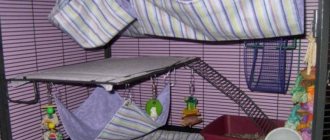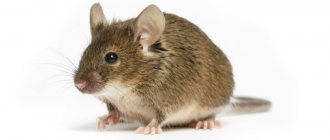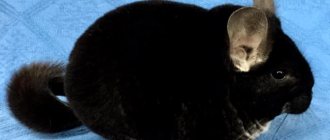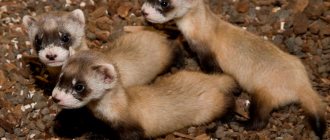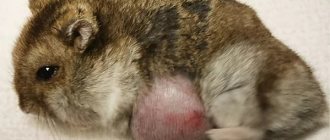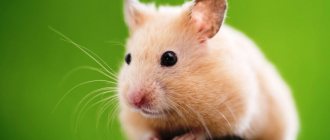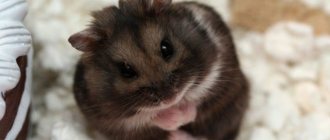Mice are small animals belonging to the class of mammals, an order of rodents from the mouse family.
They are found everywhere. The vast majority of their species live in tropical and subtropical forests, with fewer in the temperate and northern latitudes of Europe and Asia, as well as on the Australian mainland. There are approximately 13 species of mice common in the Russian Federation.
In total, the mouse family list includes 147 genera and 700 species. The size of the animal ranges from 5-48 cm, depending on the type of animal.
Below in the article we will try to describe what types of mice there are, how many species of them are found in Russia, what types of mice live where, and also provide their names, descriptions and photos.
Baby mice
They are one of the smallest rodents on earth. The size of an adult does not exceed 7 cm, the tail - 6-7 cm. The baby weighs no more than 10 g.
The appearance of the animal, namely its coloring, distinguishes it from other species. The fur of these mice is bright red in color, except for the abdomen, which is almost white.
Habitat: Spain, Korea, Japan, southern Kazakhstan, China and northern Mongolia. They are found in forests, fields and forest-steppe. In the summer they build nests in the grass, and in the winter they move into burrows, haystacks, and human dwellings.
Baby mice quickly adapt to their new environment. They are quite peaceful and calm. They can live in captivity. At the same time, the animals need a large, capacious cage or a small terrarium so that the little ones can move and climb freely.
In food, it prefers seeds, cereals, legumes, and small insects.
Nutrition
Typically, these animals, which live in their natural environment, feed on grains, grain stalks, and seeds. They like any plant food - tree fruits, grass seeds and everything that can be obtained from a plant. If this rodent lives near human habitation, then its menu is much more varied.
Here bread, vegetables, and sausage are already eaten - the mouse is not capricious in its choice. It also happens that mice eat their weaker brothers, but this happens if the mice are locked together in a cage and there is nowhere else to get food. Rats do the same.
If you manage to buy a mouse as a pet, then you can feed it with cereals, bread, cheese, vegetables, as well as any plant food, but it is better to stick to a diet that is close to the natural diet of these animals. You should feed your pet once a day; overfeeding these babies can lead to diseases.
House mouse
The ability to get along with humans has made these animals the most common species of the mouse family and the most numerous of the mammals on earth. Distributed everywhere. The Far North, Antarctica, and highlands are places where these rodents are absent due to low temperatures and high humidity.
These mice are perhaps the smallest representatives of their family, if you do not take into account the tiny mice. The length of their body is no more than 10 cm, the tail is 5-10 cm. The animal has gray fur on its back, sides and a light belly. House mice that live in desert areas are sandy yellow in color, while domesticated house mice are white.
Unlike wild rodents, white decorative mice often become pets. In addition, they are bred in laboratory conditions as food for serpentarium pets, as well as for clinical studies as experimental animals.
In nature, rodents live in burrows. With the onset of autumn, they begin to move into residential buildings and outbuildings.
The main diet is seeds, grain, green parts of plants, and once in a person’s home, they sweep away everything that comes their way - from bread crumbs to soap and candles.
General characteristics of mouse representatives
The mouse family is diverse. Mice are omnivores and herbivores. Some were bred artificially so that they could be kept as pets. Habitat: all continents. The only place on the planet where mice are not found is Antarctica and mountain slopes.
Distinctive features of the appearance of mice are:
- length up to 10 cm (rare species up to 12 cm);
- fur along the entire length of the body;
- triangular muzzle;
- The ears are round, large, sticking out in different directions.
It is impossible to confuse mice with other rodents, since their size is too small. The color of the animal is varied, and only albinos have red eyes. The rest of the breeds have small black eyes.
All types of mice are fertile. Throughout the year, a sexually mature female brings up to 8–10 litters. But life expectancy does not exceed 5 years. Each litter contains from 5 to 8 mice. The duration of gestation is 21 days.
Young mice are born blind, without fur. Over the course of 14–21 days, the pups become similar to adults, but smaller in size. Completely independent, they get their own food.
Interesting fact! Reproduction activity occurs in the summer due to a sufficient amount of food. In autumn the animal is less active. In winter, the female is able to give birth only once.
Harvest mouse
Habitat: Central and Eastern Europe, the southern part of Western Siberia, China (except for the south), Mongolia, the Korean Peninsula, Taiwan. This type of rodent rarely lives in houses and outbuildings, unlike house mice.
The field mouse prefers open areas - bushes and fields. In megacities it mainly lives in green zones. Lives both in burrows and other natural shelters. Rodents that live in swampy areas build nests in bushes or grass.
The body length of the animal can reach up to 12.5 cm, the tail – up to 9 cm. The color of the field mouse is grayish-brown, with a dark stripe running along the back.
The animal’s diet, which changes depending on temporary conditions, is based on plant foods and insects. Field mice are the largest pests for agriculture and forestry, and they can also live in country houses.
Features of life
Life of a mouse The timid nature of a rodent is not at all associated with a cowardly disposition.
The small animal is forced to behave carefully, since it has plenty of enemies. A mouse in the wild is trained in various skills - crawling, swimming, digging, and some species even fly. This existence allows rodents to overcome obstacles, adapt to new conditions, and get food everywhere.
The mouse makes its home in the ground, digging out complex labyrinths, in trees, in old hollows, bird nests, and under stones. Once in a person’s house, it settles down under the floor, in the attic, between the walls. Activates activity in the dark. Tries not to go too far from the nest or burrow.
Interesting!
Most species of mice live in packs. A whole hierarchy is built with a male leader and several dominant females. Each individual is assigned a territory where it can obtain food. The Sakis raise their offspring together, but after they “come of age” they are unanimously expelled from the family to live independently.
Mice hibernate in several places:
- in holes deep in the ground;
- haystacks in the field;
- in barns, warehouses, outbuildings, sheds, and a person’s home.
Rodents that remain in the field for the winter prepare food supplies. The hole has several chambers where the mouse carries everything that is valuable to it and will save it from starvation.
Natural enemies of mice are reptiles, wild animals, hedgehogs, large birds, dogs, cats. Since in our area the reptile is not as widespread as in warm countries, predators from this genus are snakes and some species of snakes.
In nature, a living mouse exists for only 1 year. Such a short period is associated with a large number of enemies and natural disasters. The lifespan of mice is genetically determined to be about 5 years. In artificial conditions they can live for about 3 years. In the laboratory they lived until 7.
Wood mouse
The animal prefers natural shelters, its own or others' burrows in floodplains, in thickets of meadow bushes, and in open areas of forest. Their habitats are broad-leaved and mixed forests of Eastern Europe, Turkey, the Caucasus, Kazakhstan, Altai.
It reaches 10 cm in size. The length of the tail is approximately the same as the length of the body. Color – grayish-red. Some individuals have a yellow spot in the chest area.
Rodents, as a rule, feed on plant foods (grain, seeds), and do not refuse insects. They eat young tree seedlings, causing severe damage to forestry.
Description and appearance
So, who is this mouse? Mice are animals belonging to the rodent order and the mouse family. Regardless of the species, all mice are distinguished by their small size and anatomical features, namely, the presence of an elongated, pointed muzzle, a dense body, a long tail, short paws with movable fingers and tenacious claws.
Mice live all over the planet, often settling near people. Some species are classified as synanthropic.
How does a mouse skeleton work?
The mouse skull is oval, with clearly visible areas of bone fusion. Rodents have a well-developed lower jaw, which can move in different directions.
Skeleton
The mouse skeleton is light, mobile, elastic, but at the same time very durable. The neck consists of 7 vertebrae connected by a column, and there are 20 in the tail. The pubic bones of mice are connected by ligaments. Due to this, during childbirth the bones move apart and females can give birth to rather large (compared to the size of the mother) mice.
Features of teeth
The structure of a mouse's teeth is very unusual. The front incisors (2 upper and 2 lower) do not have roots and grow throughout the life of the rodent. Therefore, animals constantly have to gnaw on something very durable in order to wear down their teeth at least a little. If this is not done, the mouse will not be able to close its mouth and eat normally.
Mice have no fangs. The molars, located on the sides of the jaw, have an uneven surface. It is with their molars that rodents grind food that gets into their mouth.
Sense and smell organs
As for the senses, mice have rather poor vision, acute hearing and an excellent sense of smell. The eyes of mice are rather poorly developed; most individuals have severe farsightedness. Rodents see best in twilight, but in complete darkness they navigate with the help of sensitive vibrissae.
Mice hear very well. Their ears can even perceive ultrasound. Rodents' sense of smell is also excellent; it helps them search for food, recognize relatives and navigate the area.
Wool and color features
The body of mice is covered with thick, smooth fur. Features of coloring - on the belly the fur is lighter than on the back and sides, and the border is quite clear. The color of wild mice varies from sandy to dark brown, almost black. The most common colors are gray, brown, red. Sometimes there are stripes or spots on the skin.
It’s interesting that the further south a mouse lives, the lighter its fur.
Dimensions and physiological features
Depending on the species, the size of mice varies from 6 to 18 cm, but the vast majority of rodents grow to 8 – 11 cm. The length of the tail can range from 60 to 100% of the body length, in some individuals the tail is even slightly longer. How much an animal weighs depends on its size. The average weight of a mouse is about 20–25 g.
The average body temperature of mice is +37.5…39⁰С. A rodent's heart beats at a rate of about 600 beats per minute. Mice run quite fast, many varieties can swim, but they do this only when absolutely necessary.
Differences between male and female
Sexual dimorphism in mice is not pronounced. It is impossible to distinguish a male from a female either by size, weight, or color. There may be some differences in character. According to studies, females are calmer, while males are more likely to show aggression.
Reproduction and lifespan
The mouse is a polygamous animal. Males and females do not create families and disperse immediately after mating. Rodents reach sexual maturity at three months of age. Pregnancy lasts 18–22 days, after which 3 to 10 pups are born. The cubs are born completely helpless. They have no fur, ears and eyes are closed.
With little mice
Mice are mammals. The female feeds the mice for the first 3 weeks after birth. In the fourth week of life, the pups become independent. Mice can breed all year round. During the year, the female brings from 3 to 9 litters.
Typically, the lifespan of a mouse in nature is 1.5–2 years, but in general rodents can live 5–7 years.
Vole mouse
Distinctive features of this type of rodent are their short tail, small ears and small muzzle. The length of the mouse's body, not including the tail, is 12 cm. The color is gray or dark brown, the abdomen is gray.
Habitat: North Africa, Middle East, northern India, southwestern China, Taiwan, Japanese Islands, North America.
Like a mole, the vole digs deep, multi-pass burrows. The animals are active at night and are underground during the day. They feed on plant foods - green parts of plants, roots, tubers.
You can try to fight small rodents using ultrasound.
How are farmers harmed?
Mice, like many other rodents, cause a lot of damage to farms. Here's why mice are dangerous:
- mice carry dangerous diseases (typhoid, plague, salmonellosis, etc.);
- they leave their excrement wherever they run and climb (various infections are also transmitted to people through feces);
- chew wires, furniture, walls and other household items;
- Mice are dangerous for the garden: they spoil the harvest (they gnaw the bark of fruit trees and their roots, eat the harvest);
- They eat the feed of farm animals and leave their excrement in it, which leads to food spoilage.
Video
Varieties
House mice live everywhere. This is facilitated by high adaptive capacity. The animals tolerate cold and heat relatively well and adapt to any living conditions. Close proximity to humans ensures survivability - a minimum of enemies, a large amount of food. A typical representative of mice can be found outdoors and indoors. Lives in garages.
House mice are the most common experimental specimens in laboratories. Over many years of work, breeders have intentionally or unintentionally bred many different subspecies of house mice. But several have been officially identified.
House mouse classification:
- musculus – has become widespread in Poland, Northern and Eastern Europe, and parts of Russia;
- bactrianus - an interesting species of domestic mice found in Asia;
- domesticus - a heat-loving species found in Southern Europe, America, Africa, Australia;
- castaneus is another representative of Asia, only in the southeastern part.
Types of mice
For a long time, there was another type of domestic mouse - Mmmolossinus. Rodents have become widespread in Japan. However, later scientists stated that this species cannot be classified as a separate type, since they obtained the animals by crossing Mmmusculus, Mmcastaneus.
Natural enemies
House mice are hunted by cats, foxes, small mustelids, mongooses, large lizards, snakes, birds of prey, crows, and shrikes. Rats also often kill and eat their smaller counterparts.
But house mice can also be predators. So, they were brought to the South Atlantic island of Gough, took root and multiplied to a number of 700,000 individuals. Later, large mice began to attack albatross chicks; in a year they destroy more than 1 million chicks.
